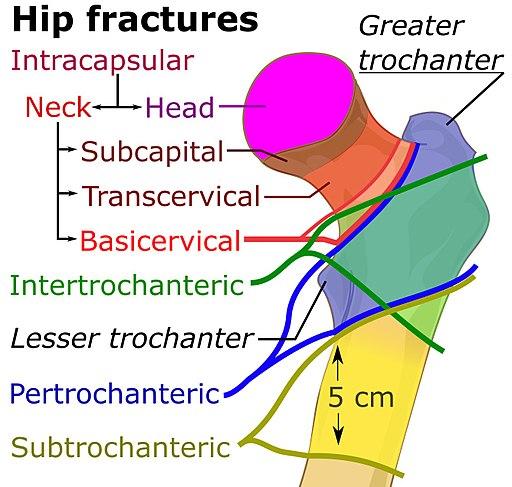While hip fractures can occur for anyone, the majority of patients are elderly individuals who have fallen. There is good evidence to show that expeditious surgery, within 24 hours of the injury, results in fewer medical complications and lower costs. A recent article in the Canadian Medical Association Journal sought to tease out the frequency of delays in care and their causes.
Using administrative data, the researchers looked at patients with hip fractures calculating the wait times from arriving in the emergency department to entering an operating room. 42,230 patients, 522 different surgeons, 963 anesthesiologists and 72 hospitals. The mean age of patients was 80, 70% were women. The mean time from "door to knife" was 38 hours, only 33% of patients underwent surgery within the recommended 24-hour window. So what took so long? The short answer, inter-hospital transfers, and preoperative evaluation.
Hospital transfer
Because our northern neighbor has regionalized care to a greater degree than here in the US, where this approach is gaining traction, the findings are instructive. After all the statistical adjustments, transferring a patient from an emergency room in one hospital to a larger regional center where surgery was performed added 24 hours to the wait time. The delay can be due to a variety of factors including the time involved in accepting the patient, the presence of an “open bed” to place them in and whether they are transported by ambulance or helicopter. While I could not find good data on the transfer time frame in the US, as a practicing physician I can say that we sometimes had to jump through multiple hoops in getting a hospital to accept a transfer (and in this instance we are talking about academic centers accepting transfers from community hospitals), arranging transportation and a range of logistic issues. There are solutions include developing agreements between hospitals to facilitate transfers as we are doing with tele-neurology for treatment of strokes. But as hospitals consolidate and we regionalize care so that patients are treated in “high-volume” centers, we need to develop efficient transfer protocols otherwise emergent care [1] will be delayed.
Preoperative evaluation
The researchers found that 9% of patients had acute medical problems “that may have benefitted from medical treatment (and delay) before surgery.” But physicians requested a preoperative consultation with either an internal medicine specialist or by an anesthesiologist 76% of the time. 5% of patients underwent an echocardiogram, a non-invasive test that looks at the function and contractility of the heart. While consultation added only 6 hours to delays, those echocardiograms added 18 hours. The study did not answer the question of whether all of those consultations were necessary and there is no information on how the echocardiogram results altered management. But you need to ask yourself, were all those consultations required, did they improve outcomes? Most surgeons and anesthesiologists, through the experience of many cases, can tell you who needs further preparation, a number which I think is closer to the 9% the researchers identified, than the 76% who were seen with an eye towards our old friend, an abundance of caution.
The researchers found that most of the variability in delay was attributable to the hospital where care was provided, not the surgeons or anesthesiologists. And this brings us to a particularly touchy issue, the scheduling of care. There is a tension between physicians who want to work relatively normal hours, hospitals that want to save money by not staffing services that are not utilized 24 hours a day and patients who need care irrespective of the time of day. Emergencies can happen anytime, so how do you reconcile, the time-pressure for emergent care, hospital staffing and physician workload [2]. The bottleneck is the scheduling of the operating room.
The nightmare of the operating room schedule
You can see the scheduling problem in the researcher's data, patients admitted over the weekend had much-decreased wait-times because the operating rooms were not filled with elective surgery. Similarly, patient’s admitted after hours also showed decreased wait times because they could be prepared overnight and added to the next day’s schedule. It was those pesky patients who insisted on fracturing their hip during regular work hours that suffered the most extended delays. Their care was delayed twice. First, their medical consultations were postponed till later in the day when an internist or anesthesiologist could see them and once a final decision was made “clearing” them to proceed they were put at the end of the OR schedule after the previously scheduled, elective cases. (It is difficult to send a same-day surgery patient home when surgery doesn’t get started until mid-afternoon.)
These scheduling problems are well known in the surgical community, and various means have been employed to reduce them; for example, often an operating room is kept open only for emergencies. But to administrators this is lost time and money, leaving a room open for emergencies means it isn't“productive.” If the masters of artificial intelligence are looking for a project, finding a way to effectively schedule operative cases for patients and physicians would be welcomed.
[1] Emergency care involve life threatening problems and is always addressed immediately, emergent or urgent care are the problems that need attention sooner rather than later and can be triaged to “wait a bit.”
[2] Physician workload translates into late hours and fatigued physicians. There are work rules in place limiting work hours for residents and many are pushing for the same for physicians equating fatigued care with drunk driving.
Source: Reporting and evaluating wait times for urgent surgery for hip fractures in Ontario, Canada CMAJ DOI: 10.1503/cmaj.170830




